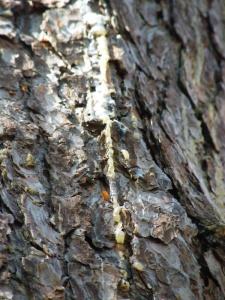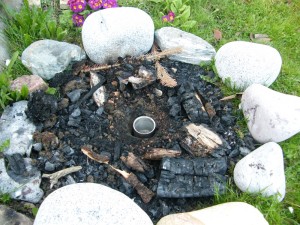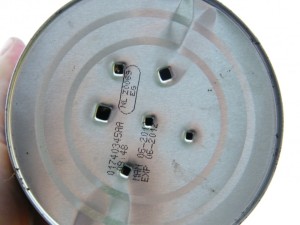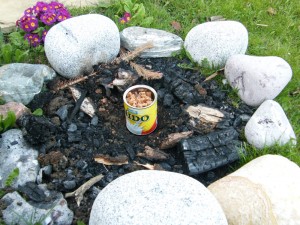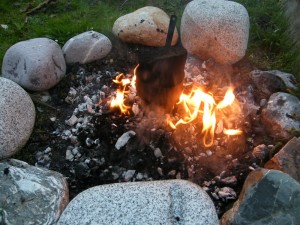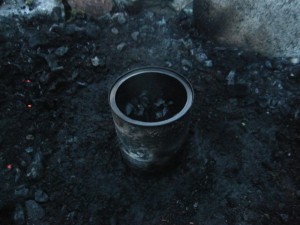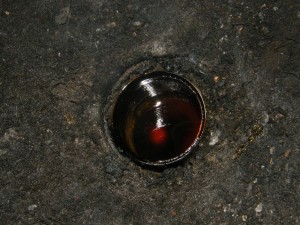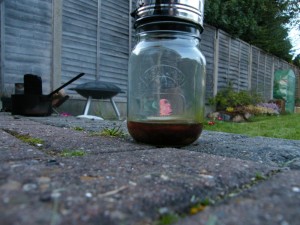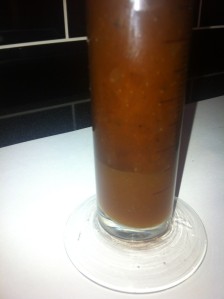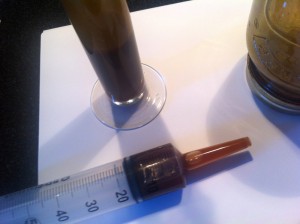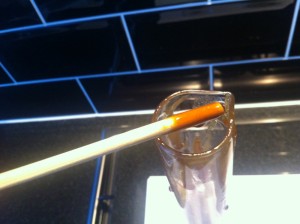Blog Archives
Making Pine Tar
I’m pretty sure that everyone would recognise the smell of this stuff, even if they couldn’t name it. It is known to us in many forms from pine tar soap to a wood preservative that coats our fences. It’s been used to protect boats, it forms the basis for a natural glue (when combined with powdered charcoal and dry animal droppings) and even has medicinal qualities that are still used to this day: it is used as an expectorant to loosen mucus, it’s used as an anti-septic for horse and cattle hooves and as I mentioned before make a great addition to soap used to help skin conditions such as eczema and dandruff.
I wanted some, in fact more than that I wanted to make some.
I saw videos of some people making it from great chunks of pine resin so I went along to my local nature reserve (which has a lot of pine trees in it) hoping to see some oozing out of a tree (it seeps out of wounds on a tree to help seal them in much the same was that scabs soon form on our wounds), but the nature reserve was so well managed that all the wounds on trees from fallen or chopped branches were plugged and so there was very little sap to be found…
I did find a small amount though, but not enough for what I wanted…
So I decided to try to extract the pine tar from some “Fatwood” (resin soaked pine wood that occurs naturally in the stumps of fallen pine trees).
First I sank a tin can into the ground of my firepit so that the top was level with the surface.
Then I made holes in the base of a larger tin which would house the fatwood sticks.
Then I filled the tin with fatwood sticks and placed it over the can so that it was touching the top of the collection can.
…and lit my fire which burned for around 2 hours (after placing a pot on the fatwood can to act as a lid and weighing it down with a rock).
After the fire had died down I removed the rock and lid and found that I’d pretty much made charcoal as expected but that the charcoal was still a bit glossy. I took this to mean that I could have extracted more tar if I’d kept the fire going for longer.
As for the collection can, it had a fair amount of a thick fluid in it which smelled very strongly of a cross between pine tar soap and creosote. There were a few lumps of much thicker darker tar in the bottom.
Once I’d transferred the oil / tar to a jar I could see that it had tar in it, but also whitish fluid which, after shaking, remained mixed and didn’t separate out much after 24 hours (at least not in the wide jar that I’d put it into).
I suspected that I had made some sort of pine tar oil and that I could have reduced it down (being cautious of the vapours and also igniting it) to a tar.
…but I still wanted to know what was separating out of my pine tar, so I transferred it into a measuring cylinder and left it for a while as the taller and narrower measuring cylinder would make it easier to see the layers.
After only an hour or so it separated into a thicker tar which remained on top of a lighter coloured much thinner fluid…
Then I removed the lower fluid with a syringe…
…leaving behind the much thicker (and flammable) tar…
I had initially assumed that the thinner fluid was water, but as it sank to the bottom I doubted that it was and I wasn’t happy adding it to soap until I knew what I’d made.
My latest guess is that it is Pine Tar Acid which I found mentioned in this paper:
http://his.library.nenu.edu.cn/uploa…li/114/343.pdf
It’s described as being heavier than the pine tar and as separating out from the mixture:
The raw material was big, old stumps from Scots pine (Pinus SylTestris), from trees felled about 50 years earlier. At this stage, the remains primarily consist of resinous heartwood, which is carefully rinsed during autumn season, dried and chopped by axe in frosty weather in the wintertime into pieces approximately 30–40 cm long and 4–5 cm thick. The wood sticks were stacked in the following summer, due to tradition. The wood was stacked ﰀhemisphericallyﰁ on a funnel shaped platform on top of a birch bark layer. Eight thermo-elements where installed in the stack during construction to measure temperatures every 10 min during the burning process. The wood stack was finally covered with heather turf except along the base, where the kiln was ignited. It was allowed to catch fire properly before being covered by turf all over. In the centre of the funnel was a drain hole, which lead to a hollowed-out log underneath from which the tar was tapped off in portions of 10–20 l directly into barrels. The kiln consisted of approximately 35 m3 of wood, burned for 45 h and gave about 1050 l of tar and 230 l of ‘tar acid’. Tar acid is an acidic water phase, heavier than tar, which gradually separates from the tar during storage and which is usually removed after a couple of weeks.
So after reading this I took the PH of the thinner liquid and found that it was acidic.
The thicker tar smells much better and I’m happy now with what I’ve made and plan to upscale the process so that I have enough for a decent batch of soap.

